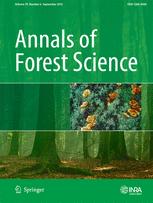Ver ítem
- xmlui.general.dspace_homeCentros Regionales y EEAsCentro Regional Patagonia SurEEA Santa CruzArtículos científicosxmlui.ArtifactBrowser.ItemViewer.trail
- Inicio
- Centros Regionales y EEAs
- Centro Regional Patagonia Sur
- EEA Santa Cruz
- Artículos científicos
- Ver ítem
Survival and growth of Nothofagus pumilio seedlings under several microenvironments after variable retention harvesting in southern Patagonian forests
Resumen
Context:
Variable retention prescriptions for Nothofagus pumilio forests provide for biodiversity conservation and natural regeneration by controlled opening of the canopy. Harvesting generates different microenvironments which present dissimilar conditions for seedling establishment, due to positive or negative influences over biotic and abiotic factors.
Aims:
This study evaluated seedling survival and performance in different microenvironments
[ver mas...]
Context:
Variable retention prescriptions for Nothofagus pumilio forests provide for biodiversity conservation and natural regeneration by controlled opening of the canopy. Harvesting generates different microenvironments which present dissimilar conditions for seedling establishment, due to positive or negative influences over biotic and abiotic factors.
Aims:
This study evaluated seedling survival and performance in different microenvironments within the harvested stands. Tested hypotheses stated that seedling stress and performance were influenced by harvesting due to changes in forest structure, microclimate, soil properties, and nutrient availability.
Methods:
In the stands harvested by variable retention, five contrasting microenvironments were selected as treatments for the experiments and sampling. Environmental variables were related to ecophysiological, seedling survival, and performance.
Results:
The modification of forest structure (crown cover and tree density) and the presence of coarse woody debris greatly affect the effective rainfall and global radiation reaching understorey level, influencing seedling stress and consequently survival and performance. Harvesting also modifies soil properties (e.g., soil bulk density) and coarse woody debris accumulation which in turn influences soil moisture and/or solar radiation levels. Analyses showed that seedlings received benefits of microenvironment variation after harvesting. Areas covered with middle or fine woody debris presented regeneration with better ecophysiological response and seedling performance, although dispersed retention areas (far away from remnant trees) and roads could also present suitable conditions for seedling survival and performance.
Conclusions:
The proportion of different microenvironments in the harvested forests will determine the amount of natural recruitment of regeneration and consequently the success of proposed silvicultural management. Forest practices must be manipulated to increase the proportion of favorable microenvironments (e.g., woody debris), allowing greater natural regeneration success during the first years after harvesting.
[Cerrar]

Autor
Martínez Pastur, Guillermo José;
Soler Esteban, Rosina Matilde;
Cellini, Juan Manuel;
Lencinas, María Vanessa;
Peri, Pablo Luis;
Neyland, Mark Geoffrey;
Fuente
Annals of forest science 71 (3) : 349–362. (May 2014)
Fecha
2014
Editorial
INRA : Springer
ISSN
1286-4560
1297-966X (Online)
1297-966X (Online)
Formato
pdf
Tipo de documento
artículo
Palabras Claves
Derechos de acceso
Restringido
 Excepto donde se diga explicitamente, este item se publica bajo la siguiente descripción: Creative Commons Attribution-NonCommercial-ShareAlike 2.5 Unported (CC BY-NC-SA 2.5)
Excepto donde se diga explicitamente, este item se publica bajo la siguiente descripción: Creative Commons Attribution-NonCommercial-ShareAlike 2.5 Unported (CC BY-NC-SA 2.5)

